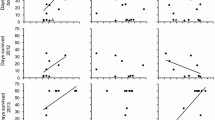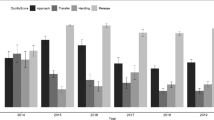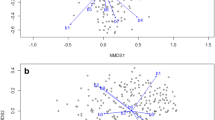Abstract
Many behavioural traits show important inter-individual phenotypic and genetic variation despite strong potential selection that should reduce this variability. Spatial and temporal heterogeneity in environmental conditions has been proposed to maintain such variation but empirical evidences supporting this hypothesis are still scarce for behavioural traits. Here, we analysed the repeatability and the ecological and individual factors that influence the expression of docility across different environmental contexts in wild eastern chipmunks (Tamias striatus) studied over a period of 10 years. We also estimated the heritability of docility and the patterns of viability selection acting on this trait for adults and juveniles. Docility was moderately repeatable among various contexts and was positively affected by age, was higher in males than that in females, was higher during the fall and decreased with population density. Heritability of docility was low at 0.17. We found disruptive selection for the survival of adults only, individuals more or less docile than average having a higher survival. Our study confirms that docility is both phenotypically and genetically variables and that disruptive selection might maintain the variability in this trait.
Significance statement
Documenting the factors allowing the maintenance of phenotypic and genetic variation of behavioural traits within natural populations is a central objective in ecology and evolution. Here, we studied a wild eastern chipmunk population over 10 years and recorded docility, a personality trait, on both juveniles and adults. We showed that docility was repeatable and that it was also heritable and influenced by different individual and environmental factors. Importantly, we also found that disruptive viability selection was acting on adult docility independently of environmental variations. Our results show that docility is both phenotypically and genetically variable and that patterns of selection acting on this trait can maintain personality heterogeneity across temporally varying environmental conditions in the wild.




Similar content being viewed by others
References
Anderson SJ, Fike JA, Dharmarajan G, Rhodes OEJ (2007) Characterization of 12 polymorphic microsatellite loci for eastern chipmunks (Tamias striatus). Mol Ecol Notes 7:513–515
Bates D, Mächler M, Bolker BM, Walker SC (2015) Fitting linear mixed-effects models using lme4. J Stat Softw 1:1–48
Bell AM, Hankison SJ, Laskowski KL (2009) The repeatability of behaviour: a meta-analysis. Anim Behav 77:771–783
Bell G (2010) Fluctuating selection: the perpetual renewal of adaptation in variable environments. Philos T Roy Soc B 365:87–97
Bergeron P, Montiglio PO, Réale D, Humphries MM, Gimenez O, Garant D (2013) Disruptive viability selection on adult exploratory behaviour in eastern chipmunks. J Evol Biol 26:766–774
Bergeron P, Réale D, Humphries MM, Garant D (2011a) Anticipation and tracking of pulsed resources drive population dynamics in eastern chipmunks. Ecology 92:2027–2034
Bergeron P, Réale D, Humphries MM, Garant D (2011b) Evidence of multiple paternity and mate selection for inbreeding avoidance in wild eastern chipmunks. J Evol Biol 24:1685–1694
Biro PA, Stamps JA (2008) Are animal personality traits linked to life-history productivity? Trends Ecol Evol 23:361–368
Boake CRB (1989) Repeatability: its role in evolutionary studies of mating behavior. Evol Ecol 3:173–182
Boon AK, Réale D, Boutin S (2007) The interaction between personality, offspring fitness and food abundance in North American red squirrels. Ecol Lett 10:1094–1104
Burnham K, Anderson D (2002) Model selection and multimodel inference: a practical information-theoretic approach. Springer, New York
Calsbeek R, Smith TB (2008) Experimentally replicated disruptive selection on performance traits in a Caribbean lizard. Evolution 62:478–484
Careau V, Bergeron P, Garant D, Réale D, Speakman JR, Humphries MM (2013) The energetic and survival costs of growth in free-ranging chipmunks. Oecologia 171:11–23
Careau V, Montiglio P-O, Garant D, Pelletier F, Speakman JR, Humphries MM, Réale D (2015) Energy expenditure and personality in wild chipmunks. Behav Ecol Sociobiol 69:653–661
Careau V, Thomas DW, Humphries MM (2010) Energetic cost of bot fly parasitism in free-ranging eastern chipmunks. Oecologia 162:303–312
Chambers JL, Garant D (2010) Determinants of population genetic structure in eastern chipmunks (Tamias striatus): the role of landscape and sex-biaised dispersal. J Hered 101:413–422
Choquet R, Lebreton J-D, Gimenez O, Reboulet AM, Pradel R (2009a) U-CARE: utilities for performing goodness of fit tests and manipulating CApture–REcapture data. Ecography 32:1071–1074
Choquet R, Rouan L, Pradel R (2009b) Program E-SURGE: a software application for fitting multievent models. In: Thomson DL, Cooch EG, Conroy MJ (eds) Modeling demographic processes in marked populations. Springer US, New York, pp 845–865
Class B, Kluen E, Brommer JE (2014) Evolutionary quantitative genetics of behavioral responses to handling in a wild passerine. Ecol Evol 4:427–440
Dingemanse NJ (2002) Repeatability and heritability of exploratory behaviour in great tits from the wild. Anim Behav 64:929–938
Dingemanse NJ, Both C, Drent PJ, Tinbergen JM (2004) Fitness consequences of avian personalities in a fluctuating environment. Proc R Soc Lond B 271:847–852
Dingemanse NJ, Kazem AJN, Réale D, Wright J (2010) Behavioural reaction norms: animal personality meets individual plasticity. Trends Ecol Evol 25:81–89
Dingemanse NJ, Réale D (2005) Natural selection and animal personality. Behaviour 142:1159–1184
Dingemanse NJ, Réale D (2013) What is the evidence that natural selection maintains variation in animal personalities? In: Carrere C, Maestripieri D (eds) Animal personalities: behavior, physiology, and evolution. The University of Chicago Press, Chicago, pp 201–220
Dochtermann NA, Schwab T, Sih A (2014) The contribution of additive genetic variation to personality variation: heritability of personality. Proc R Soc B 282:20142201
Dubuc-Messier G, Garant D, Bergeron P, Réale D (2012) Environmental conditions affect spatial genetic structures and dispersal patterns in a solitary rodent. Mol Ecol 21:5363–5373
Endler JA (1986) Natural selection in the wild. Princeton University Press, Princeton, NJ
Falconer DS, Mackay TF (1996) Introduction to quantitative genetics, 4th edn. Longman, Harlow
Ferrari C, Pasquaretta C, Carere C, Cavallone E, von Hardenberg A, Réale D (2013) Testing for the presence of coping styles in a wild mammal. Anim Behav 85:1385–1396
Grant PR, Grant BR (2002) Unpredictable evolution in a 30-year study of Darwin’s finches. Science 296:707–711
Griffiths RA, Foster JP (1998) The effect of social interactions on tadpole activity and growth in the British anuran amphibians (Bufo bufo, B. calamita, and Rana temporaria). J Zool 245:431–437
Hadfield JD (2010) MCMC methods for multi-respoinse generalized linear mixed models: the MCMCglmm R package. J Stat Softw 33:1–22
Hendry AP, Huber SK, De León LF, Herrel A, Podos J (2009) Disruptive selection in a bimodal population of Darwin’s finches. Proc R Soc Lond B 276:753–759
Kalinowski ST, Taper ML, Marshall TC (2007) Revising how the computer program CERVUS accommodates genotyping error increases success in paternity assignment. Mol Ecol 16:1099–1106
Kingsolver JG, Hoekstra HE, Hoekstra JM, Berrigan D, Vignieri SN, Hill CE, Hoang A, Gibert P, Beerli P (2001) The strength of phenotypic selection in natural populations. Am Nat 157:245–261
Kingsolver JG, Pfennig DW (2007) Patterns and power of phenotypic selection in nature. Bioscience 57:561–572
Korpela K, Sundell J, Ylönen H (2011) Does personality in small rodents vary depending on population density? Oecologia 165:67–77
Landry-Cuerrier M, Munro D, Thomas DW, Humphries MM (2008) Climate and resource determinants of fundamental and realized metabolic niches of hibernating chipmunks. Ecology 89:3306–3316
Le Coeur C, Thibault M, Pisanu B, Thibault S, Chapuis JL, Baudry E (2015) Temporally fluctuating selection on a personality trait in a wild rodent population. Behav Ecol 26:1285–1291
Lessells CM, Boag PT (1987) Unrepeatable repeatabilities: a common mistake. Auk 104:116–121
Martin JGA, Pirotta E, Petelle MB, Blumstein DT (2017) Genetic basis of between-individual and within-individual variance of docility. J Evol Biol 30:796–805
Martin JGA, Réale D (2008) Temperament, risk assessment and habituation to novelty in eastern chipmunks, Tamias striatus. Anim Behav 75:309–318
Montiglio P-O, Garant D, Bergeron P, Dubuc-Messier G, Réale D (2014) Pulsed resources and the coupling between life-history strategies and exploration patterns in eastern chipmunks (Tamias striatus). J Anim Ecol 83:720–728
Montiglio P-O, Garant D, Pelletier F, Réale D (2012) Personality differences are related to long-term stress reactivity in a population of wild eastern chipmunks, Tamias striatus. Anim Behav 84:1071–1079
Montiglio P-O, Garant D, Thomas D, Réale D (2010) Individual variation in temporal activity patterns in open-field tests. Anim Behav 80:905–912
Munro D, Thomas DW, Humphries MM (2008) Extreme suppression of aboveground activity by a food-storing hibernator, the eastern chipmunk (Tamias striatus). Can J Zool 86:364–370
Nakagawa S, Schielzeth H (2010) Repeatability for Gaussian and non-Gaussian data: a practical guide for biologists. Biol Rev 85:935–956
Petelle MB, Martin JGA, Blumstein DT (2015) Heritability and genetic correlations of personality traits in a wild population of yellow-bellied marmots (Marmota flaviventris). J Evol Biol 28:1840–1848
Petelle MB, McCoy DE, Alejandro V, Martin JG, Blumstein DT (2013) Development of boldness and docility in yellow-bellied marmots. Anim Behav 86:1147–1154
Peters MB, Glenn JL, Svete P, Hagen C, Tsyusko OV, Decoursey P, Lieutenant-Gosselin M, Garant D, Glenn TC (2007) Development and characterization of microsatellite loci in the eastern chipmunk (Tamias striatus). Mol Ecol Notes 7:877–879
Poissant J, Réale D, Martin JGA, Festa-Bianchet M, Coltman DW (2013) A quantitative trait locus analysis of personality in wild bighorn sheep. Ecol Evol 3:474–481
Quinn JL, Patrick SC, Bouwhuis S, Wilkin TA, Sheldon BC (2009) Heterogeneous selection on a heritable temperament trait in a variable environment. J Anim Ecol 78:1203–1215
Réale D, Festa-Bianchet M (2003) Predator-induced natural selection on temperament in bighorn ewes. Anim Behav 65:463–470
Réale D, Gallant B, Leblanc M, Festa-Bianchet M (2000) Consistency of temperament in bighorn ewes and correlates with behaviour and life history. Anim Behav 60:589–597
Réale D, Garant D, Humphries MM, Bergeron P, Careau V, Montiglio PO (2010) Personality and the emergence of the pace-of-life syndrome concept at the population level. Philos T Roy Soc B 365:4051–4063
Réale D, Martin J, Coltman DW, Poissant J, Festa-Bianchet M (2009) Male personality, life-history strategies and reproductive success in a promiscuous mammal. J Evol Biol 22:1599–1607
Réale D, Reader SM, Sol D, McDougall PT, Dingemanse NJ (2007) Integrating animal temperament within ecology and evolution. Biol Rev 82:291–318
Roff D (1997) Evolutionary quantitative genetics. Springer US, New York
Schuett W, Dall SRX (2009) Sex differences, social context and personality in zebra finches, Taeniopygia guttata. Anim Behav 77:1041–1050
Siepielski AM, DiBattista JD, Carlson SM (2009) It’s about time: the temporal dynamics of phenotypic selection in the wild. Ecol Lett 12:1261–1276
Siepielski AM, Gotanda KM, Morrissey MB, Diamond SE, DiBattista JD, Carlson SM (2013) The spatial patterns of directional phenotypic selection. Ecol Lett 16:1382–1392
Sih A, Bell A, Johnson JC (2004) Behavioral syndromes: an ecological and evolutionary overview. Trends Ecol Evol 19:372–378
Smith BR, Blumstein DT (2008) Fitness consequences of personality: a meta-analysis. Behav Ecol 19:448–455
Spiegelhalter DJ, Best NG, Carlin BP, van der Linde A (2002) Bayesian measures of model complexity and fit. J R Stat Soc B 64:583–639
Stamps J, Groothuis TGG (2010) The development of animal personality: relevance, concepts and perspectives. Biol Rev 85:301–325
Stirling DG, Réale D, Roff DA (2002) Selection, structure and the heritability of behaviour. J Evol Biol 15:277–289
Taylor RW, Boon AK, Dantzer B, Réale D, Humphries MM, Boutin S, Gorrell JC, Coltman DW, McAdam AG (2012) Low heritabilities, but genetic and maternal correlations between red squirrel behaviours. J Evol Biol 25:614–624
Taylor RW, Boutin S, Humphries MM, McAdam AG (2014) Selection on female behaviour fluctuates with offspring environment. J Evol Biol 27:2308–2321
Tremmel M, Müller C (2013) Insect personality depends on environmental conditions. Behav Ecol 24:386–392
van Oers K, de Jong G, van Noordwijk AJ, Kempenaers B, Drent PJ (2005a) Contribution of genetics to the study of animal personalities: a review of case studies. Behaviour 142:1185–1206
van Oers K, Klunder M, Drent PJ (2005b) Context dependence of personalities: risk-taking behavior in a social and a nonsocial situation. Behav Ecol 16:716–723
van Oers K, Sinn DL (2013) Quantitative and molecular genetics of animal personality. In: Carrere C, Maestripieri D (eds) Animal personalities: behavior, physiology, and evolution. The University of Chicago Press, Chicago, pp 149–200
Webster MM, Ward AJW (2011) Personality and social context. Biol Rev 86:759–773
Wilson AJ, Réale D, Clements MN et al (2010) An ecologist’s guide to the animal model. J Anim Ecol 79:13–26
Wolf M, van Doorn GS, Leimar O, Weissing FJ (2007) Life-history trade-offs favour the evolution of animal personalities. Nature 447:581–584
Acknowledgments
We are grateful to Murray M. Humphries, Fanie Pelletier, Patrick Bergeron and Pierre-Olivier Montiglio for their contribution to this project. We also want to thank the Ruiter Valley Land Trust and Nature Conservancy of Canada for allowing us to conduct this research on their lands. We thank two anonymous reviewers for comments on previous versions of this manuscript and all field assistants, coordinators and students who have helped to collect data in the field. This research was funded by a team grant from the Fonds de Recherche du Québec - Nature et Technologies (FRQNT) to DR, DG, M.M. Humphries and F. Pelletier; by Natural Sciences and Engineering Research Council of Canada (NSERC) discovery grants to DR, DG as well as to M.M. Humphries and F. Pelletier; and by Canada Research Chair funds to DR and F. Pelletier.
Author information
Authors and Affiliations
Corresponding author
Ethics declarations
Ethical standards
Animals were captured and handled in compliance with the Canadian Council on Animal Care, under the approval of the Université de Sherbrooke Animal Ethics Committee (protocol number: DG2011–01-Université de Sherbrooke).
Conflict of interest
The authors declare that they have no conflict of interest.
Additional information
Communicated by A. I. Schulte-Hostedde
Electronic supplementary material
ESM 1
(DOCX 829 kb).
Rights and permissions
About this article
Cite this article
St-Hilaire, É., Réale, D. & Garant, D. Determinants, selection and heritability of docility in wild eastern chipmunks (Tamias striatus). Behav Ecol Sociobiol 71, 88 (2017). https://doi.org/10.1007/s00265-017-2320-6
Received:
Revised:
Accepted:
Published:
DOI: https://doi.org/10.1007/s00265-017-2320-6




